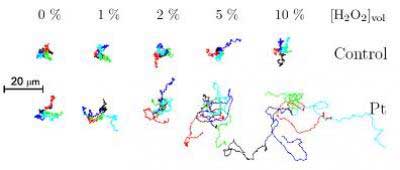| Posted: July 16, 2007 |
Microscopic polystyrene balls - now jet-propelled |
|
(Nanowerk News) A collaboration of British and Iranian physicists has created an armada of self-propelled polystyrene balls about as wide as a strand of your hair. Their efforts are moving toward self-propelled nanoswimmers that could navigate narrow channels such as the human circulatory system.
|
|
The researchers, led by Ramin Golestanian of the University of Sheffield, coated one side of each polystyrene ball with a thin layer of platinum before dropping them into a solution of hydrogen peroxide and water. This metal catalyzes a reaction in which hydrogen peroxide breaks into oxygen and water. Because the reaction spits out three molecules for every two that it consumes, the polystyrene ball is pushed from the platinum side.
|
 |
Platinum treated microspheres (bottom row) travel large distances in comparison to the untreated spheres. (Image: J. Howse, R. Jones, A. Ryan, T. Gough, R. Vafabakhsh, and R. Golestanian, Physical Review Letters)
|
|
Objects as small as these polystyrene balls naturally wander about randomly, a phenomenon caused by jostling about among vibrating atoms and molecules. This "random walk" movement is called Brownian motion. To account for it, the platinum-coated balls were tested against polystyrene balls with no coating.
|
|
Over short distances, they found that the half-coated balls moved in a particular direction although their paths meandered over longer distances. Still, the wanderings of the coated balls were distinct from the Brownian motion of the uncoated balls. Their paths were a random walk with step sizes that depended on the concentration of hydrogen peroxide. The larger the hydrogen peroxide concentration, the larger the step.
|
|
Physicists have yet to devise a way to keep the balls heading in a particular direction, but chemical reaction catalysis may prove a useful method for propelling microscopic objects in liquids.
|

